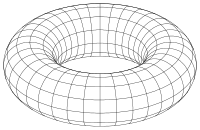Implicit surface

Imagine you have a magic paintbrush that can create shapes out of thin air. But instead of drawing a shape with lines, you can draw it by wrapping a big balloon around it.
That's sort of like what happens with an implicit surface. Instead of creating a shape from lines or points like you might see in a drawing or sculpture, an implicit surface is defined by a special kind of equation that tells you whether a point is inside or outside the shape.
So you take a bunch of points in space, and you plug each one into the equation. If the answer is negative, the point is inside the shape, and if it's positive, the point is outside. Then, you can use all those points to make a picture of the shape.
What makes this special is that the equation can be really complex, and it can describe shapes that you might not be able to draw with a regular paintbrush. You might be able to make shapes with wavy surfaces or strange twists and turns that don't have a simple description.
Overall, implicit surfaces are a way to create and work with very complex shapes using a kind of mathematical magic that lets you answer the question "Is this point inside or outside my shape?" in a way that helps you create a picture of it.
That's sort of like what happens with an implicit surface. Instead of creating a shape from lines or points like you might see in a drawing or sculpture, an implicit surface is defined by a special kind of equation that tells you whether a point is inside or outside the shape.
So you take a bunch of points in space, and you plug each one into the equation. If the answer is negative, the point is inside the shape, and if it's positive, the point is outside. Then, you can use all those points to make a picture of the shape.
What makes this special is that the equation can be really complex, and it can describe shapes that you might not be able to draw with a regular paintbrush. You might be able to make shapes with wavy surfaces or strange twists and turns that don't have a simple description.
Overall, implicit surfaces are a way to create and work with very complex shapes using a kind of mathematical magic that lets you answer the question "Is this point inside or outside my shape?" in a way that helps you create a picture of it.
Related topics others have asked about:
